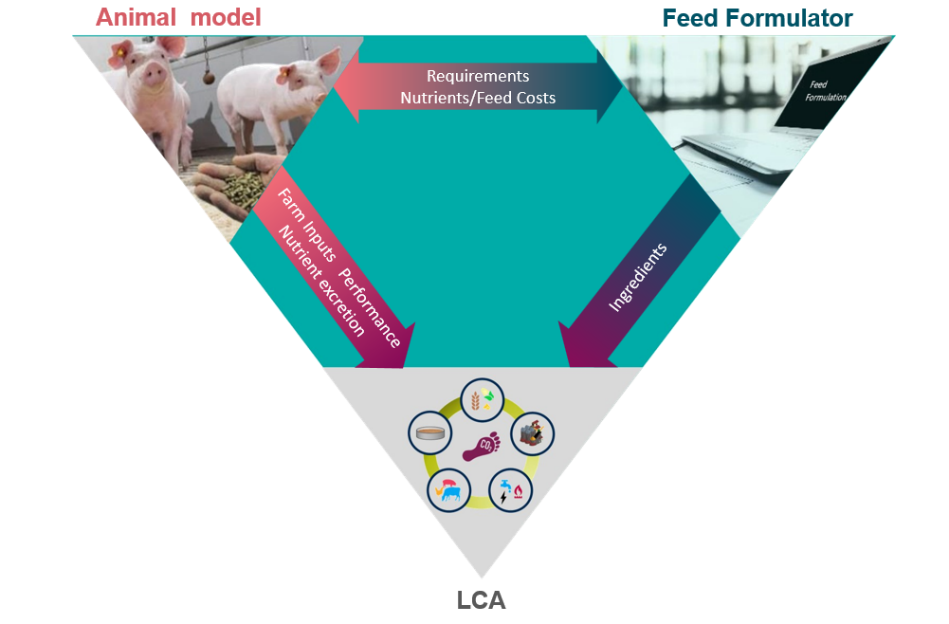Climate effects swine can now be measured with Watson
- Sustainable precision farming
- 2021
- Sustainability
- R&D
As carbon taxes and climate change influence the economics and environmental aspects of farming, Trouw Nutrition, Nutreco’s animal nutrition division, is introducing a life cycle analyses (LCA) component to its proprietary Watson® predictive service tool. Going beyond the ability to optimize the nutritional and economic profile of feed, Watson predicts how changes to feed inputs and farm management can influence environmental indicators such as climate change, eutrophication, acidification, land use, renewable resources, and water scarcity. The integrated service tool evaluates inputs to predict outcomes across animal production phases and at critical points along the supply chain. A series of systems integrates animal biology, feed formulation, and environmental conditions into a life cycle analysis model for driving decisions that support animal performance, farm economics and environmental stewardship (Figure 1).

The footprint of global food production
Many factors contribute to greenhouse gas emissions, including food production which accounts for 27.6% of the total emissions. As animal agriculture is committed to reducing its contribution, Trouw Nutrition continues to support efforts in this area. Watson considers how feed intake influences not just the animal, but the environment. The model can predict the levels of environmental pollutants such as nitrogen and phosphorous that will be retained in the animal vs. excreted into the environment. Other aspects of farm management and food production, such as shipping, refrigeration and processing that can contribute to the environmental footprint of food production are also integrated into the model.
The life cycle assessment feature of Watson is powered by SimaPro, a third-party software that allows for real-time calculations. The LCA methodology incorporates European Feed Manufacturers' Federation (FEFAC) and ISO standards for calculating the environmental footprint, as well as Global Feed LCA Institute (GFLI) agri-footprint and Ecoinvent data, and Intergovernmental Panel on Climate Change (IPCC) Tier 2 emissions. Calculations also incorporate ingredient transport method and shipping distances. Feed formulation and production changes can be evaluated in context with animal genetics and the individual farm’s health status and management practices such as housing and waste management.
Figure 1
Watson can help forecast the farm economics associated with management changes. For example, a farm could compare the amount of nitrogen emitted into the atmosphere from manure stored in an open lagoon to emissions from manure stored in a closed tank. While constructing a concrete tank for waste could be costly, model analysis has shown that replacing an open lagoon with a closed tank could potentially reduce carbon output by 30%. In light of pending carbon taxes and contingent upon other variables, constructing a closed system could make sense from both an economic and environmental perspective.
Supporting decisions across the supply chain
Beyond its application on the farm, Watson can assist in making ingredient purchase decisions and drive technical and operational decisions ranging from pig flows to shipping. Integrators can evaluate how changes will influence the supply chain from farm to fork and genetics companies can use the model to determine nutrient requirements as they change genetics.
Sustainability on the farm is becoming even more important as countries are considering carbon taxes for the agricultural sector. Climate change is bringing a sense of urgency and this model’s use of third-party software and real-time data drives a high-integrity footprint data set to support decisions.
Improving precision, reducing variance
Watson aims to reduce variation and improve predictability in livestock production. The integrated model allows users to conduct opportunity analysis and compare actual market results to model predictions. In most cases, the variance is within five percent. From a precision nutrition perspective, users can see how each nutrient in a ration is contributing to the overall environmental profile of an operation and supports animal performance. Watson can examine transport components and energy utilized on the farm, providing a good overview of opportunities to optimize energy efficiency.
Traditionally, models delivered information about the financial and animal effects that could be expected from different choices, but environmental indicators have lagged behind. With Watson, users can tap into insights that will continue to benefit animal and financial outcomes, while addressing the importance of environmental sustainability.
The Watson model is used by Trouw Nutrition’s compound swine feed operations. In the future, Trouw Nutrition will offer a similar process to support producers of other species.